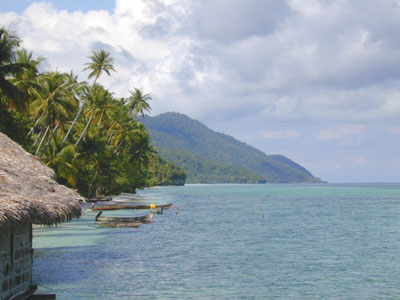
Kri (Mansoear) Island, Raja Empat Islands, Papua Barat, Indonesian New Guinea

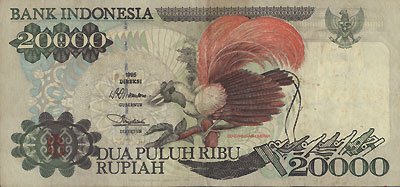
| After leaving Los Angeles International Airport at 1:30 AM on Singapore Airlines (wonderful service!), we arrived 12 hours later into Taipei. After a one hour layover, it was on to Singapore where we had a five hour stopover. Then it was another flight to Makassar, Sulawesi (formerly known as Ujung Pandang). By the time we had walked into our "over the sea cottage", we had been in transit for 27 hours! But we felt fit and rested the following morning and were off for a day tour of the area. We were assisted by Caraka Travelindo in arranging our stay and tour. Our guide , Andarias , spoke excellent English and showed us a wonderful time. Andarias is highly recommended to anyone visiting the area. He is from Torajaland and is well-versed in its traditions and customs. He is charming and helpful and made our stay a delightful one! We visited a marketplace and purchased delicious bananas, saw bamboo being transported on the Talo River, splashed in the Bantimurung Waterfall north of the city, saw butterflies and thousands of fruit bats roosting saw incredible rock formations, marveled at prehistoric paintings in caves, and met some charming people. Shopping in Makassar is very interesting. |
 |
 |
 |
|
|
 |
| The boat trip to Kri (Mansoear) Island was quite a ride! We passed Batanta Island, the only home of the rare Wilson's Bird of Paradise. As we had left the harbor we saw a foreboding black horizon ahead, indicating a storm was brewing. Max said the weather had been unusually windy the past few days with attendant rough seas. As we motored into the storm, the wind picked up and the temperature dropped several degrees. The driver of the boat had to slow our pace as the waves made navigation more difficult. A cold hard rain began to fall as waves crashed over the side of the boat, soaking us all. After a while, the wind and rain subsided and a beautiful hot sun broke through the clouds, warming us as we had our first glimpse of the Irian Diving dive camp. Suddenly a loud raucous cawing noise pierced the tranquility. "Caw, caw, caw, caaaaaaaaw, caaaaaaaaw, caaaaahhhhw!" was our first introduction to the magnificent bird life of Kri Island as we heard our first Torresian Crow. We nicknamed this specie the "Sarcastic Crow" as it cawed in a peculiar way like no other crow we had ever heard! |
 |
|
One of the highlights at mealtime
was the chance to cuddle and feed the baby
couscous! This delightful little animal was only six weeks when we arrived and was still taking milk but soon began to eat solid food as encouraged by the guests who took turns holding and feeding her. She was a wonderful addition to our experience on the island! Within a few months, she will begin to venture to the trees outside but will probably return to the dining area for free hand-outs as other couscous have done in the past. |
 |
|
Dawn of the first morning was
heralded by a cacophony of bird songs and sounds! (Click
here for a full list of common and scientific names of all
birds seen on Kri Island.) At first light (about 5:30 A.M.),
Blyth's Hornbills could be heard, grunting quietly in the canopy
of trees over the camp area. Soon the melodious songs of the
Butcherbirds filled the air, accompanied by the not-so-melodious
squawkings of numerous Red-Sided Eclectus. Flocks of Red-Flanked
Lorikeets and Red Lories sped by, their high-pitched voices adding
to the bird symphony. The Torresian Crows and Pacific
Imperial Pigeons added their own special "songs"
and the Singing Starlings and Willie Wagtails trilled melodically
from the rooftops of our rooms and nearby palm trees. The screaming
of a Triton Cockatoo and high-pitched chirping of a Red-Cheeked
(Geoffrey's) Parrot convinced me that I'd better get up and look
at the birds! It was wondrous to see Eclectus Parrots fly by
and the sound of the wing beats of the hornbills was curiously
loud. The morning symphony was usually over by 7:30 or 8:00 AM;
however, the calls of Eclectus, Triton Cockatoos, lories, crows,
and pigeons could be heard throughout the day. Check back soon to hear audio files of the bird sounds at dawn and to see a video clip of Blyth's Hornbills flying! |
 |
|
On our third day, we were taken to a beautiful area characterized by multitudes of small mushroom-shaped islands, thick with tropical vegetation. Wild orchids, palms, cycads, Casurina trees, Pandanus, and other plants covered their slopes. The day was overcast and rainy but it was still incredibly beautiful. We passed small villages and pearl farms. We were to dive at a spot known as "The Passage" which is a thin ocean-filled area between two islands that resembles a river. As we rounded a bend we came upon the a small outrigger canoe that was modified into a sort of "houseboat". A family of four with their two dogs was on a day's outing from a nearby village. They graciously allowed us to take many photographs and we left them with a bit of the food we had brought for our lunch. We had two wonderful dives in the area which was characterized by many colorful sea fans, soft corals, tunicates, flatworms, nudibranchs, cuttlefish, and anglerfish. Fallen logs underwater that were festooned with sponges and sea fans, low visibility, and the overcast day made it a bit eerie underwater. After our dives, we explored the area a bit, visiting a large cave inhabited by five species of bats, and a burial area in the seacliffs. Human bones, old tea kettles and tea cups, and broken pottery were scattered in a small cave. We quietly visited but were careful not to disturb anything. |
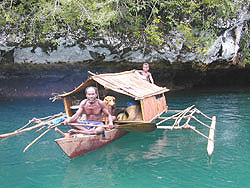  |
| Everyday life on the island was interesting as there was new construction going on and work crews from villages on neighboring islands arrived daily to work. We did not speak the same language so we could not communicate in that way. However, the men were intrigued with the digital camera and delighted in seeing images of themselves. It was a good thing that we had lots of rechargeable batteries as we went through batteries fast, showing the people their images. These men were skillful at building over the water structures with wood poles, bamboo, and pandanus. It was amazing to see how quickly a structure would take shape. It was a treat to see these men leave on their long canoes every evening to go home to their villages. Often, a brilliant sunset would silhouette their boats against the sky. This became a favorite photo subject. (See our Irian Sunset Photo Gallery for images of these boats in the early evening light.) |
 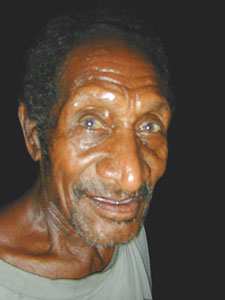 |
|
There is no scuba diving at Irian Diving on Saturdays as the owners and some of the staff are Seventh Day Adventists. This "day of rest" tuned into a day of exertion for me! Dawn found me sitting on the wharf, bird-watching with three local children who, with the help of my trusty "Birds of New Guinea" book by Bruce M. Beehler, Thane K. Pratt, and Dale A. Zimmerman, helped me to identify some of the local avian species. One young fellow, Mehta, was quite good at identifying the island birds. Soon there were a number of people on the dock, looking at birds! Suddenly Mehta silently pointed toward the shore. We were surprised to see a young Dwarf Cassowary standing at the end of the dock. The bird had been brought from another island a week ago (having been raised by the camp staff on the other island) and had been hiding in the jungle for the past week. Soon the kitchen staff brought bananas to feed it. It ate about a dozen bananas whole, peel and all. As the days went by, the cassowary became more comfortable around people and began to bathe in the sea and approach people with curiosity. After breakfast on Saturday, several of us attempted to hike up to the crest of the island. On the path up, we saw a Monitor Lizard and some wild terrestrial orchids blooming. It was very hot and humid and there was no breeze under the dense canopy of trees. The path was nearly straight up and was treacherous with loose sharp rocks, tree roots, fallen branches, and huge spider webs with huge spiders! Not a single bird was seen nor heard under the dense forest canopy. Even though he was barefoot, Max went up the path swiftly and even carried my camera! Even with his help, I gave up a few hundred feet from the top! After stumbling back down the hill, hot and a bit bruised, I spent a refreshing hour snorkeling. Late morning found some of us performing chores, relaxing, taking photos, sea kayaking, or snorkeling in the shallow area around camp that teamed with sea life. After lunch, several of us went by boat to a local village on a visit organized by Max. This village is on the larger island of Waigeo, which is home to the Red Bird of Paradise, (as depicted on the 20,000 Rupiah bill that appears near the top of this page) and the Black Palm Cockatoo, . Max had asked that a local gentleman, who was very familar with the birdlife, take us up into the forest on an hour-long hike to attempt to see the Birds of Paradise displaying in their lek. We were greeted by many members of the village. Max translated to us and explained that there were about forty-five families in the village. Their main source of income is the collection and drying of sea cucumbers for the Asian Market. The village was well-organized and clean and was beautifully planted with blooming exotic flowers. After a short visit, we crossed a bridge where a man was fishing in a rushing estuary and entered the forest on a path that took us up hills, by fields of tuberous crops, and through dense undergrowth. With Max translating, we learned that Black Palm Cockatoos visit the fields each morning and are there at 8:00 AM when the people arrive to work with their crops. While standing in this clearing we saw Eclectus fly over and heard a Triton Cockatoo. The walk was brisk and arduous. I brushed by a shrub full of large ants and had them climbing all over my head and neck! Finally we reached the base of a small heavily-forested hill. We were warned to stay very quiet and soon we heard the display call of the Red Bird of Paradise! There were a variety of strange sounds, some of them sounding other-worldly. We crept forward and strained to look upward through the dense canopy. It had begun to rain lightly and our bird expert indicated that it was not a good day to see the birds and that we were a bit late as well. We were thrilled to hear the rustling of the plumes as the male birds thrust them over their backs in courtship. It was amazing how loud this was. Alas, we were unable to actually see the birds. We returned to the village a bit bedraggled and wet with aching calf muscles. It seemed the entire village was waiting for our return. The children approached cautiously and we took some digital photos and showed these to them. They were quite interested but would not smile for the camera. Suddenly an idea came to me. I can make a high-pitched trilling sound that my pet mynah, Maynard, can imitate. As I asked to take another photo I said "OK, one, two" and then made the loud trilling noise. The children all broke out into smiles and laughter! From that point on, they anticipated the noise and all smiled right on cue for our photos. We really enjoyed our visit with these gentle people and really wanted to return the following Saturday to attempt to see the birds but it was unable to be arranged. Next time...! |
    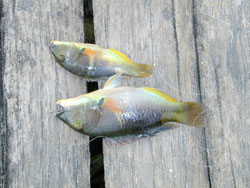 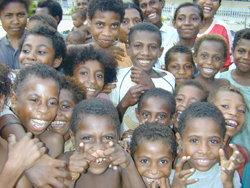  |
|
Diving was varied and exciting with the nearly ever-present currents keeping us on our toes! We dove on a P-40 aircraft at 38 meters (115 feet) depth off Wai Island. At the end of this beautiful dive, we saw two absolutely huge giant clams, one green and the other blue. They were nestled deep into the reef and surrounded by huge anemones with attendant families of clownfish, some of the largest I have ever seen. Another day, another diver and I experienced the dreaded vortex currents again! This current sucks you down deep very quickly and spins you around, with your bubbles circling your head, kind of like an underwater tornado. Take it from me- try to avoid doing this! We really loved diving on Sardine Reef where there were always huge schools of fish and Bumphead Parrotfish grazed like buffalo. Cape Kri was always exciting with barracuda schools, clouds of Heniochus Bannerfish, large groupers, batfish, squadrons of tangs, turtles, sharks, and hundreds of species of tropical fish! Mike's Point had strong currents and very interesting topography. One of our favorite dive sites was Melissa's Garden. We left early in the morning in bright sunshine and a flat glassy sea and made it to the little mushroom-shaped islands in about a hour's time. Our first dive was on a beautiful wall festooned with sponges and soft corals. The next two dives were shallow, right by the little islands. This colorful area is wonderful for photography, offering both wide angle and macro opportunities for the underwater photographer. Click here to see underwater photos from this area. |
 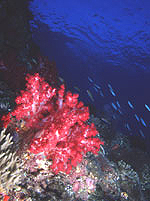 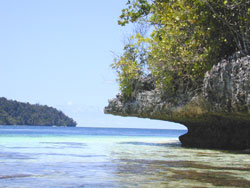 |
 |
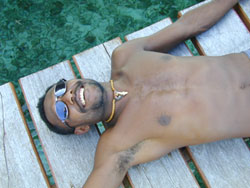 |
| As the moon began to grow fuller over the days, the evenings became more magical on the island. There were uncountable bright stars in the dark night and the starlight and moonlight glowed faintly over the calm ocean. Phosphorescence in the water mirrored the stars in the sky. Fireflies in the forest mirrored the sea. Often we sat on the dock after dinner, marveling at the cosmos and watching meteors streak against the sky. As the moon grew, the night bird noises became more numerous. Marbled Frogmouths warbled plaintively late at night. A bird we nicknamed the "alarm bird" made a faint sound like an alarm or telephone ringing in the distance, starting at about 4:00 AM. |
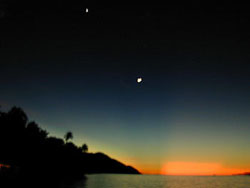 |
|
What an interesting trip this was! As we packed up to leave we realized what a special experience it had been. We were treated so well by the staff of Irian Diving! This tranquil paradise was hard to leave. Going back to "civilization" seemed a bit shocking! The electric lights were too bright, the food was too rich, but the warm showers DID feel good! We returned by way of Makassar, spending a day shopping, shopping, shopping for 22 karat gold. (Take cash as the shops do not accept credit cards!) Another day was spent dining and shopping in the lovely city of Singapore and then we boarded Singapore Air flight 006 for the return to Los Angeles via Taipei. Exactly one week earlier, on 10/31/00, this flight had crashed on takeoff, killing eighty-two people on board and injuring many more! It was a bit sobering to pass through Taipei airport and reflect upon what had happened there just a few days ago. I will always remember the many friends I met on the trip and the beauty of the place is forever embedded in my mind. I shall return. (I DID return in 12/02- The Hornbill) |
 |
|
|
Irian Sunset Photo Gallery |
|
|
|
|